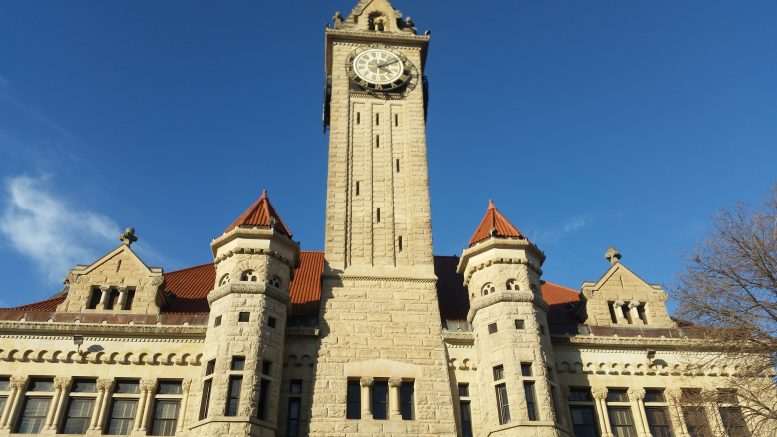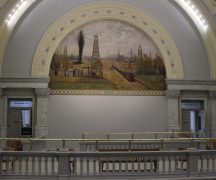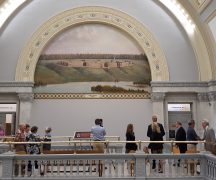By JAN LARSON McLAUGHLIN
BG Independent News
In the past 200 years, Wood County has gone from nearly impenetrable swamp land, to rich oil fields, to fertile farmland and hub of higher education.
Now, as Wood County is getting ready to celebrate its 200th year, citizens are being invited to join in a birthday bash.
The county’s bicentennial celebration is being combined with the 125th year of the county courthouse in 2021.
So the first event will be held Sept. 9, at 3 p.m., as the restored murals on the third floor of the courthouse will be rededicated.
“That kicks off things,” Wood County Commissioner Doris Herringshaw said.
Then a “Gala Dinner and Benefit for the Anniversary Celebration” is scheduled for Oct. 26, starting with a social hour at 5:30 p.m. on the third floor of the Wood County Courthouse, followed by a dinner at 6:30 p.m. in the courthouse atrium.
The gala dinner on Oct. 26 will feature a presentation on local history, plus a medley of patriotic music.
The cost is $100 per person – with that money going toward programs to help celebrate Wood County’s bicentennial in 2020.
Seating is limited to about 125, and reservations must be made by Oct. 10. Checks should be payable to Wood County Bicentennial, and mailed to the Wood County Committee on Aging, 305 N. Main St., Bowling Green.
The celebrations will continue into 2020, when county officials hope to offer some memorabilia, and possibly hold an ice cream social.
“We’re exploring all kinds of ideas,” Herringshaw said. “If someone had ideas, let us know.”
The organizers are hoping to create some type of county bicentennial display or parade float that can travel to community fairs and festivals throughout the county in 2020.
“We want to add on to what is already being done in those communities,” Herringshaw said.
Working on the county bicentennial efforts with the county commissioners are Wood County Common Pleas Judge Matt Reger, Wood County Auditor Matt Oestreich, and retired county auditor Mike Sibbersen.
“We’re hoping to kick off some enthusiasm” with the gala dinner in October, Oestreich said.
A line of Wood County bicentennial clothing is being offered. The shirts, featuring the county logo, are available online through the end of August, according to Oestreich. Information on the clothing and other events planned can be found at woodcounty200.org.
Though more events may be added, these are programs have been scheduled so far:
- Sept. 9, 3 p.m.: Wood County Courthouse Mural Rededication, Wood County Courthouse
- Oct. 26, 5:30 p.m. Hors d’Oeuvres/6:30 Dinner: Gala Dinner & Benefit for the Anniversary Celebration
- Feb. 8, 2020, 9 a.m.-3 p.m.: I Love Wood County Scavenger Hunt, Wood County District Public Library, Second Floor Information Desk
- June 6, 2020, 10 a.m.: Wood County 200 Walking Tour, Wood County District Public Library Carter House
- July 21, 2020: Anecdotes & Obits: Exploring Wood County History in the Newspaper, Wood County District Public Library, Second Floor Meeting Room
- Aug. 6, 2020, 2 p.m.: The Jack Armstrong Collection & Wood County’s Silver Screens, Wood County District Public Library, Second Floor Meeting Room
- Aug. 13, 2020, 2 p.m.: Wood County Silver Screening (Film TBA), Wood County District Public Library, Second Floor Meeting Room
- Aug. 20, 2020, 2 p.m.: Wood County Silver Screening (Film TBA), Wood County District Public Library, Second Floor Meeting Room
- Aug. 27, 2020, 2 p.m.: Wood County Silver Screening (Film TBA), Wood County District Public Library, Second Floor Meeting Room
- Oct. 27, 2020, 6:30 p.m.: Wood County Haunted History, Wood County District Public Library
A Wood County Bicentennial Committee has been created to promote the 200th anniversary, and to preserve pictures, memorabilia, and documents.
The committee “calls upon all citizens to participate by submitting memories, photos, or volunteering at events to help everyone in Wood County understand our county’s history and recognize its contribution to our shared story,” the bicentennial website states.
Following is a brief history of the county:
Wood County is located on land that was once one of the thickest and most dangerous parts of the Great Black Swamp, and so, while Native American tribes like the Wyandot and Ottawa sometimes traveled through the area, they did so only when absolutely necessary.
After the Battle of Fallen Timbers, the land was deeded to Native Americans as part of the 1795 Treaty of Greenville, but the United States government purchased it back from the Wyandot, Ottawa, Delaware, Potawatomi, Seneca, Shawnee, and Chippewa tribes through the Lower Maumee Treaty of 1817.
On Feb. 12, 1820, the Ohio State Legislature authorized the creation of Wood County, along with 13 other counties, on this land. Wood County was named after Colonel Eleazer D. Wood, who was the planning engineer of Fort Meigs, and it included the area that would eventually separate to become Lucas County in 1835. Perrysburg was designated as Wood County’s seat in 1822, but it was changed to the more central location of Bowling Green in 1868.
Settlement of the county was extremely difficult, but an extensive system of ditches was developed in order to drain the rich farmland under the swamp. Today, there are still more than 3,000 miles of drainage ditches keeping the county dry.
In the late 1800s, the first industries came to Wood County when oil and natural gas were discovered. The first oil field was located in North Baltimore in 1886, but eventually, oil was found in at least 16 townships. The oil and gas boom of the late 1800s caused a huge population increase, as people flocked to the county with the hopes of making it rich. The population of Wood County was 9,157 in 1850, and by the early 1900s, it was over 60,000.
Wood County currently covers approximately 620 miles of land and water. It includes 19 townships, 21 villages, and five cities. At the time of the 2010 census, the county’s population was just over 125,000, and Bowling Green is currently the largest community in the county.
The committee will also bring attention to the 125th anniversary of the Wood County Courthouse in 2021. The courthouse opened on Sept. 29, 1896 and has been in use continuously since that time.




